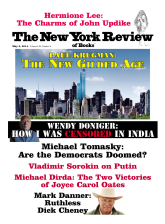In response to:
Will Scotland Go Independent? from the March 20, 2014 issue
To the Editors:
As an Englishman, I gained new insights into the “West Lothian Question” and other constitutional issues for the United Kingdom as indirectly put in novel context by Jonathan Freedland in his article about Scottish independence [NYR, March 20]. But three issues appeared to be missing from his treatise.
1) How will the social welfare policies still in force north of the border survive independence when English subsidies from taxation of the rampant capitalism in the southeast of England are no longer available?
2) As Lowland Scots have always tended to side with the English in the intertwined histories of the two countries, how will their split allegiances affect the forthcoming poll?
3) What would the poll result be if the whole of the UK voted on Scottish independence? My sense is that the tribalism infecting the (rich) north/(poor) south debate in Italy, exemplified by the Lega Nord, might also be found in other parts of Britain. Racial rivalry and competition can sadly be found in places other than Murrayfield’s rugby stadium.
John Fidler
Marina Del Rey, California
Jonathan Freedland replies:
John Fidler’s first question rests on an assumption that would be strongly disputed by those campaigning for Scottish independence. He speaks of “English subsidies” for Scotland (and he is far from alone in that), but Nationalists reject the notion that Scots are dependent on handouts from the London exchequer. Both sides have figures to cite. Defenders of the union like to say that Scotland has only 8.4 percent of the UK population, contributes a mere 8.3 percent of the UK’s total output—yet receives 9.2 percent of total UK public spending. Nationalists counter that, while it’s true that Scotland receives 9.2 percent from the UK’s coffers, that’s less than the 9.4 percent of total UK revenue Scotland pays in.
The difference between these two estimates of the Scottish contribution is North Sea oil and gas. The 8.3 percent figure excludes oil revenues; the 9.4 percent figure includes them. How you count depends on whether you accept the 1970s Nationalist slogan—“It’s Scotland’s Oil”—or whether you believe that the natural resources of the relevant area of the North Sea belong to the entire United Kingdom. In the event of a Yes vote, this would be a far from academic question: negotiations between London and a newly independent Edinburgh would inevitably include an argument over who owns the oil. The Yes camp says that the conventional method of determining ownership of undersea resources—drawing a “median line” on which all points are equidistant from the coastlines of Scotland and the rest of the UK—would result in 90 percent of North Sea oil being allocated to Scotland. London is bound to dispute that view strongly.
It’s also worth pointing out that plenty of Yes voters, even if they accepted the pro-union figures on subsidy, would argue that the very idea of reliance on the “rampant capitalism” of the southeast of England is one of the reasons they are seeking independence in the first place.
As for Lowland Scots and their allegiances, most analysts seem to regard that as an outdated prism through which to view Scottish affairs—not least because in the 2011 parliamentary elections, the SNP won throughout the country, the Lowlands included. It does remain true that the “central belt” contains the bulk of the Scottish population and is where elections—and referendums—are won and lost.
Finally, polling suggests that if the whole UK were granted a vote in September’s referendum, the verdict would be No to independence. According to a survey for The Observer newspaper in March of this year, 61 percent of voters in England and Wales said they would prefer that Scotland stay in the UK with just 22 percent urging the Scots to go their own way.



